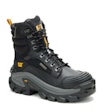
The frequency with which a construction worker should wash a winter work jacket depends on a number of factors, including the type of type of work that is being performed and the conditions in which that work is being conducted as well as how often the jacket is being worn.
Worksite conditions and job functions may necessitate washing a work jacket more often.
In cold climates in which a winter work jacket is worn with regularity, cleaning it every few weeks may be indicated. If a winter work jacket is worn infrequently in more mild weather, it may be washed once or twice during the cold season and spot cleaned as needed. Winter work jackets can be spot cleaned with a soft, dry brush or a wet cloth.
Materials and Signs to Consider
Winter work jacket material and insulation will dictate how the jacket should be washed and with what frequency. Laundry experts note that winter work jackets made of wool, leather or down should be cleaned twice a season if they are worn regularly and at least once if worn less often.
Wool coats and leather work jackets require special care for which machine or hand washing may not be suitable. In that case, dry cleaning should be considered. An insulated winter work jacket can be washed every two to three weeks. A down-filled winter work jacket may require more specialized care than those insulated with synthetic materials. A fleece winter work jacket should be cleaned after being worn about six times.
One of the most obvious signs that a winter work jacket should be washed is when there are noticeable odors and stains.
If a construction worker sweats profusely while wearing a winter work jacket or if the jacket gets wet due to snow or rain, washing it helps prevent the growth of bacteria and mold.
Those who work in a significantly dirty environment in which the jacket is exposed to oil, grease and other contaminants should wash a jacket more frequently.
Those who will be washing the winter work jacket should consult the manufacturer’s instructions by checking the care label on the jacket. Some winter work jackets are designed to be machine washable, while others may require more specialized care, such as handing the jacket over to professional cleaning services to maintain its performance and longevity.
In cleaning a winter work jacket, read the care tag for washing instructions. Stains should be pre-treated prior to washing. Be sure to fasten zippers and buttons before cleaning to prevent snags and tears and help retain the shape of the winter work jacket.
Coats and jackets of similar materials can be washed together, but do not mix different materials when cleaning as that can lead to fading or degradation. Opt for a gentle cycle to wash sensitive work clothes.
Read More: How Do Heated Jackets Work?
Regular Maintenance
As a general rule, regular maintenance entails washing a winter work jacket at the end and beginning of the winter season which helps keep it fresh and in good shape. Washing winter coats before they are stored at the end of the season helps prolong the life of the coat and ensures that it is ready for wear in the following winter.
At the end of winter, construction workers should clean their work jacket before it is stored for the season even if there is no visible signs of dirt or dust. Cleaning a winter work jacket by finishing it off with a waterproof coating or repellant after it is dried completes the cleaning process.
In considering cleaning frequencies, a construction worker must strike a balance between keeping a winter work jacket clean and putting it through too many wash and dry cycles, resulting in the reduction of the effectiveness of water repellency or insulation. Using the expertise of a laundry and dry cleaning service may help prevent damage and save time.
These services also are indicated when dealing with high-end or specialty winter work jackets.
In storing a winter work jacket at the end of the cold season, be sure to remove all items from all pockets, zip every zipper and button each button. Place the winter work jacket in fabric bags instead of plastic bags, so the apparel has plenty of room to breathe.















